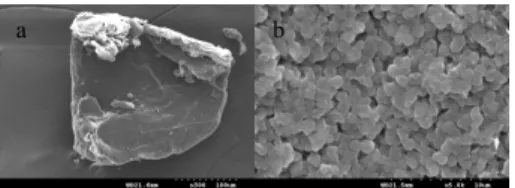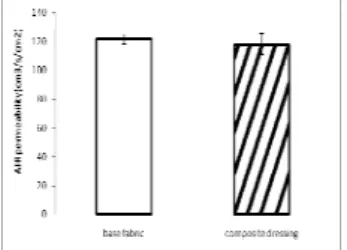Preparation of Functional Low-cohesive Composite Dressings
Ching Wen Lou
1, a, Chao Tsang Lu
2, b, Shih Yu Huang
1, c, Po Ching Lu
3,d,
Chao Chiung Huang
4, eand Jia Horng Lin
3,5 f**Corresponding author email: jhlin@fcu.edu.tw*
1
Institute of Biomedical Engineering and Material Science, Central Taiwan University of Science and Technology, Taichung 406, Taiwan, R.O.C.
2
Department of Textiles & Clothing, Fu Jen Catholic University, Taipei County 242, Taiwan, R.O.C.
3
Laboratory of Fiber Application and Manufacturing, Department of fiber and composite material, Feng Chia University, Taichung City 407, Taiwan, R.O.C.
4
Department of Textiles & Clothing, Fu Jen Catholic University, Taipei County 242, Taiwan, R.O.C.,
5
School of chinese medicin, China Madical University, Taichung, Taiwan, R.O.C.,
a
email: cwlou@ctust.edu.tw, be email: ctlu@ctust.edu.tw, c mail: pandbear205@hotmail.com,
d
email: jones198827@hotmail.com, eemail: txc11006@mails.fju.edu.tw, f, *email: jhlin@fcu.edu.tw
Keywords: sodium alginate, Chitosan, wound dressing
Abstract
Sodium alginate and Chitosan are common bio-medical dressing material, and drug delivery due to their excellent biocompatibility, biodegradability and non-toxicant. The purpose of dressing aimed at accelerating wound healing. In this study, sodium alginate/Chitosan composite solution composed of Chitosan particles and well-stirred sodium alginate solution. The PLA/cotton nonwoven was the base fabric. The sodium alginate/Chitosan composite solution was later sprayed upon the fabric, so a sodium alginate/Chitosan/PLA/absorbent cotton composite dressing was prepared. Calcium chloride was applied to strengthen the bonding between the sodium alginate/Chitosan solution and the fabric. Mechanical property and SEM of the sodium alginate/Chitosan/PLA/ absorbent cotton composite dressing’ were evaluated.
1. Introduction
Sodium alginate is composed of linear chains such as α-L-guluronic acid (G) and the β-D-mannuronic acid (M). When sodium alginate cross-links with the bivalent caution, Calcium for instance; its mechanical structure is stabilized[1]. It is a common material in bio-technology and medicine industry for the brilliant bio-degradability and bio-compatibility [2, 3, 4]. Besides, its hydrophilic group absorbs tissue fluid and blood. The calcium used to cross-link also speeds up thrombin; therefore, it is efficient for hemostasis. The sodium alginate dressing is more blood-absorbent and curative than the swab [5]. Chitin, the most abundant natural resource, is commonly found in shells of the shrimp and crab. It is chemically constructed by Glucosamine or the monomer acetoacetic Glucosamine. The used Chitosan replaces all or partial deacetylation, found on the second carbon chain, with amine [6]. It also prevents inflammation. Chitosan is biocompatible, bio-degradable, anti-bacterial and low toxic, so it is popular in tissue engineering, drug delivery and gene transferring [7, 8]. Previous research had proved that the dressing made of Chitosan and the base fabric could accelerate wound recovery [9, 10].
In this study, the Chitosan particles were mixed with the sodium alginate solution to have a
Advanced Materials Research Vols. 123-125 (2010) pp 495-498 © (2010) Trans Tech Publications, Switzerland
doi:10.4028/www.scientific.net/AMR.123-125.495
All rights reserved. No part of contents of this paper may be reproduced or transmitted in any form or by any means without the written permission of the publisher: Trans Tech Publications Ltd, Switzerland, www.ttp.net. (ID: 140.134.68.89-25/07/10,09:12:32)
Chitosan/ sodium alginate composite solution. The PLA/absorbent cotton was the base fabric. A composite dressing was produced by spry coating the Chitosan/ sodium alginate composite solution onto the PLA/absorbent cotton. Calcium chloride was used to cross-link with sodium alginate to strengthen the bond ability between the solution and the base fabric. This Chitosan/sodium alginate/PLA/absorbent cotton composite dressing (composite dressing) was put to test its tensile strength, tear strength, air permeability.
2. Materials and Methods 2.1 Materials
The Chitosan powder, the 85 % deacetylation Chitin, was purchased from the Global Bio-technology, Taiwan. Sodium alginate (food grade) was supplied by First Chemical Works, Taiwan. Tween 80 was bought from CHONEYE PURE CHEMICALS. The 99~100 % acetic acid was offered by OSAKA, Japan. The PLA fiber (melting point at 160 °C, fineness of 2 D) was supplied by Far Eastern Textile Co., Taiwan; it was 50 mm long. Absorbent cotton was 20~25 mm long with 0.9~1.7 dtex was supplied by Phenix Health & Medical Supply Corp. Taipei Taiwan. 2.2 Methods
2.2.1 Preparation of the Sodium alginate/Chitosan Composite Solution
First, Chitosan was dissolved in the 1 % acetic acid solution into a 2 wt% Chitosan solution. Then, a 20 % sodium sulphate solution and a 1 % Tween 80 (pH6-9) solution were prepared. The prepared Chitosan solution and the sodium sulphate solution were later mixed in ratio 2:1. Afterward, the Chitosan/sodium sulphate composite solution was blended with the 1 % Tween 80 solution in 1:1 and stirred for one hour. Finally, the Chitosan/sodium sulphate/Tween 80 composite solution was placed in a centrifugal and processed for 30 minutes before the precipitate was retrieved. The earned precipitate was rinsed for three times to remove extra solution; therefore, the Chitosan particles were produced[11]. Sodium alginate was dissolved in a distilled water to prepare a 2 wt% sodium alginate solution. The Chitosan particles mentioned above was then mixed and stirred with the sodium alginate solution, so Chitosan particles were dispersed evenly within the sodium alginate solution. A sodium alginate/Chitosan composite solution composite solution was completed.
2.2.2 Preparation of Composite Dressings
The PLA short fibers were mixed with absorbent cotton in weight ratio 7:3 to produce a PLA/absorbent cotton, the base fabric. A mesh was placed upon the base fabric. Then, the prepared composite solution was sprayed upon the base fabric, which was partially covered by the composite solution. The 1 wt% calcium chloride solution was applied to enhance cohesion between the composite solution and the fabric because it cross-links with sodium alginate. Finally, the fabric was thermal dried as the composite dressing.
2.3 Electron microscopy
SEM was used to study the sizes of the purchased Chitosan powders and the prepared Chitosan particles.
2.4 Mechanical Property
The mechanical properties, tensile strength and tear strength, of the base fabric and the composite dressings were examined respectively using an Instron universal materials tester (Model 5566). The CNS 5610-4.3.2 was consulted. Five specimens of each parameter were tested in MD ( 0° , machine direction) and CD ( 90° , cross direction) respectively to have the means. The space of the fixture was 25.4 mm. The pulling speed was 300 mm/min while the specimen was 180×75 mm2. The procedure of the tear strength test was referred to CNS 5610-4.10.1. Five specimens of each parameter were examined in MD and CD respectively to have the means. The space of the fixture was set at 25 mm. The pulling speed was 300 mm/min while the specimen was seized in 150×75 mm2.
2.5 Air Permeability Test
The ASTM D737 and a TEXTEST FX3300 (Germany) was applied. Five points of each specimen were tested; five specimens of each parameter were also studied to have the mean. Air was sent from one side of the fabric to another using the nozzle and adjustable pressures. The used pressure was determined by the desired amount of air passing through the 1 mm2 specimens (cm3/s/cm2). The pressure was 125 Pa.
3. Results and Discussion 3.1 Electron Microscopy Test
In Fig. 1a, the purchased Chitosan powders are of 200-250 μm. The size of the prepared Chitosan particles is around 1-2 μm Fig. 1b. The prepared Chitosan particle was smaller, so the Chitosan particles had bigger contact area which accelerated the reaction speed, enhancing its anti-bacterial ability. The prepared Chitosan particles exhibited better bacteriostatic effect, so inflammation in the early stage is prevented.
Figure 1 Size of the (a)commercial Chitosan (b) the prepared Chitosan particle
Figure 2 The maximum (a)tensile (b) tear strengths of the base fabric and the composite
dressing
3.2 Mechanical Properties
The results of tensile and tear strengths of the base fabric and the composite dressing are shown in Fig. 2 a and b. Tensile and tear strengths of the CD were bigger than those of MD. The applied machine layered the fibrous net in CD direction; thus, the produced fabric was able to sustain bigger tensile and tear forces in CD direction rather than MD. After the composite dressing was thermal dried, its tensile strength was upgraded by 24 % in MD and 8 % in the CD direction; its tear strength up-surged by 21 % in MD and 1 % in CD. The composite solution was sprayed upon the base fabric, so there were many water drops dotted on its surface. In thermal drying, those water
a b
a b
drops were hardened, and filled up the void among fibers, strengthening the fabric’s structure. Consequently, tensile and tear strengths of this composite dressing were promoted.
3.3 Air Permeability Test
Figure 3 displays air permeability results. The composite solution brought low the fabric’s air permeability. Many water drops were densely dotted on the base fabric’s surface. Simultaneously, fluid also permeated into the fabric due to surface tension. After thermal drying, those water drops formed tiny membranes in the voids among fibers. Additionally, water also bound two or more fibers together, so the voids among fibers were shrinking. As a result, the composite dressing’s air permeability was poorer than the base fabric by 3 %. From here we concluded that air permeability was barely altered by the dotted composite solution.
Figure 3 Air permeability results of the base fabric and the composite dressing 4. Conclusion
In this study, the commercial accessible Chitosan powders were processed into the Chitosan particle which was 1-2 μm big, almost 1/125~1/200 of the powder size. Tensile strengths of the composite dressing were improved by 24 % in MD and 8 % in CD; the tear strengths were also elevated by 21 % in MD and 1 % in CD. The composite dressing’s air permeability, however, slightly dropped by 3 %. That proved that the dotted composite solution hardly affected this Chitosan/sodium alginate/PLA/absorbent cotton composite dressing’s air permeability, so this composite dressing won’t humidify the wound.
5. Reference
[1] S. K. Bajpai and S. Sharma: Reactive and Functional Polymers. Vol 59 (2004) p.129–140 [2] B. Kneafsey, M. O’Shaughnessy and K.C.Condon. Burns: Vol 22 (1996), p.40-43
[3] K. Bandhyopadhyay, D. Das, P. Bhattacharyya and B. R. Maiti: Biochemical Engineering Journal. Vol 8 (2001), p. 179 –186
[4] K. Kataoka, Y. Suzuki, M. Kitada, K. Ohnishi, K. Suzuki, M. Tanihara, C. Ide, K. Endo and Y. Nishimur: Journal of Biomedical Material Researcher. Vol.54 (2001), p.373–384
[5] H. H. Steenfos and M. S. Agren: Journal of the European Academy of Dermatology and Venereology. Vol 11 (1998), p.252-256
[6] Majeti N. V. and Ravi Kumar: Reactive and Functional Polymers, Vol. 46 (2000), p.1-27 [7] Y. Uchida, M. Izume and A. Ohtakara. Chtin chitosan, Elsevier Applied Science, London and
New York, (1989), p.373–382
[8] S. Sekiguchi, Y. Miura, H. Kaneko, S. L. Nishimura, N. Nishi, M. Iwase and S. Tokura:
In :Food Hydrocolloids: Structures, Properties, and Functions, edtied by Katsuyoshi Nishinari
and Etsushiro Doi, NY(1994), in press
[9] C. W. Lou: Fiber and Polymers. Vol. 9 (2008), p.286-292
[10] C. W. Lou, C. W. Lin, Y.S. Chen, C. H. Yao, Z. S. Lin, C. Y. Chao and J. H. Lin: Textile Research Journal. Vol. 78 (2008), p.248-253
[11] R. Hejazi and M. Amiji: International Journal of Pharmaceutics. Vol. 272 (2004), p.99-108 498 Multi-Functional Materials and Structures III

